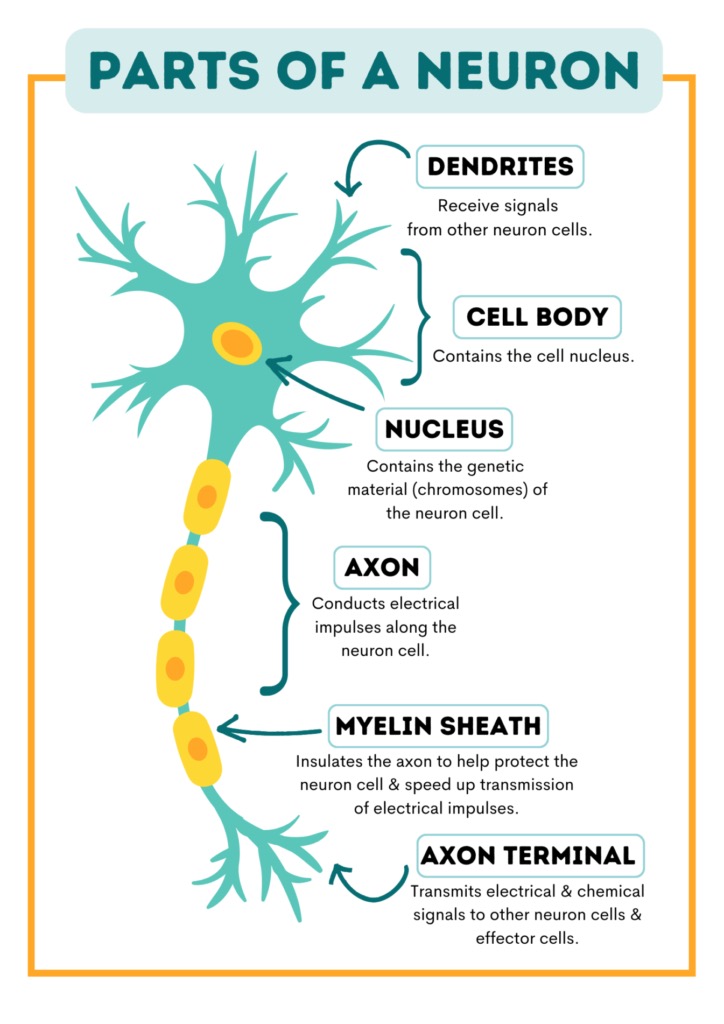85. Neurons. Types of neurons.
1/3
There's no tags or description
Looks like no tags are added yet.
Name | Mastery | Learn | Test | Matching | Spaced |
|---|
No study sessions yet.
4 Terms
neurons
Neurons are specialized nerve cells that serve as the primary signaling units of the nervous system. There are more than 10 billion neurons in the human brain alone. Each neuron is designed to receive, process, and transmit electrical and chemical signals throughout the body.

structure of neurons
Cell Body (Perikaryon or Soma):
Function: Acts as the trophic, synthetic, and receptive center of the neuron.
Size: Typically has a diameter ranging from 20-40 micrometers (µm), though sizes can vary widely (smallest: 4 µm, largest: over 120 µm).
Shape: Can vary depending on the type and location of the neuron. Common shapes include pyramidal, stellate, fusiform, and flask-shaped.
Components:
Nucleus: Large and centrally located, containing a prominent nucleolus.
Nissl Bodies: Basophilic granules composed of rough endoplasmic reticulum (RER) and free ribosomes; critical for protein synthesis. Named after Franz Nissl, who first described them.
Golgi Apparatus: Involved in the modification and packaging of proteins.
Mitochondria: Provide the energy required for various neuronal functions.
Cytoskeleton: Consists of microtubules and neurofilaments, which maintain cell shape and transport materials within the neuron.
Pigments: Includes lipofuscin (a marker of aging in neurons) and neuromelanin (found in certain areas of the brain).
Dendrites:
Function: Receive synaptic inputs from other neurons and convey these electrical signals to the cell body.
Structure: Highly branched, tree-like extensions that increase the neuron's receptive surface area.
Axon:
Function: Transmits electrical impulses away from the cell body to other neurons, muscles, or glands.
Types:
Golgi Type I Neurons: Have long axons that extend from the CNS to peripheral targets, such as motor neurons.
Golgi Type II Neurons: Have short axons and are primarily found within the CNS.
Components:
Axon Hillock: The initial segment where the axon emerges from the cell body.
Myelin Sheath: A fatty insulating layer that surrounds the axon in many neurons, speeding up the transmission of electrical signals. Formed by Schwann cells in the PNS and oligodendrocytes in the CNS.
Nodes of Ranvier: Gaps in the myelin sheath where ion exchange occurs, facilitating rapid conduction of nerve impulses.
Axon Terminals (Synaptic Boutons): Endings of the axon that release neurotransmitters into the synaptic cleft to communicate with other neurons or target cells.
morphological classification
Pseudounipolar Neurons:
Structure: Have a single process that bifurcates into two branches — one extending toward the peripheral nervous system (PNS) and the other toward the central nervous system (CNS).
Function: Commonly found in sensory ganglia (e.g., dorsal root ganglia) and are involved in sensory pathways.
Bipolar Neurons:
Structure: Possess two distinct processes — one dendrite and one axon.
Function: Typically found in the retina of the eye, olfactory epithelium (nose), and the inner ear. They are involved in sensory processing.
Multipolar Neurons:
Structure: Characterized by a single axon and multiple dendrites.
Function: The most common type of neuron in the CNS (e.g., in the brain and spinal cord). They function in integrating and processing information.
Functional Classification:
Motor (Efferent) Neurons:
Function: Transmit motor commands from the CNS to the muscles and glands in the PNS.
Types:
Somatic Motor Neurons: Control voluntary muscle movements (e.g., skeletal muscles).
Autonomic Motor Neurons: Control involuntary responses and regulate the activity of smooth muscles, cardiac muscles, and glands.
Sensory (Afferent) Neurons:
Function: Transmit sensory information from the PNS to the CNS.
Types:
Somatic Sensory Neurons: Convey information perceived consciously, such as touch, pain, and temperature from the skin, muscles, and joints.
Visceral Sensory Neurons: Convey information not perceived consciously, such as blood pressure, oxygen levels, and the state of internal organs.
Interneurons (Association Neurons):
Function: Act as intermediaries, connecting sensory and motor neurons within the CNS. They play a crucial role in reflexes, neural circuits, and higher functions such as learning and memory.
Characteristics: Typically multipolar, forming complex networks to facilitate signal integration and coordination.